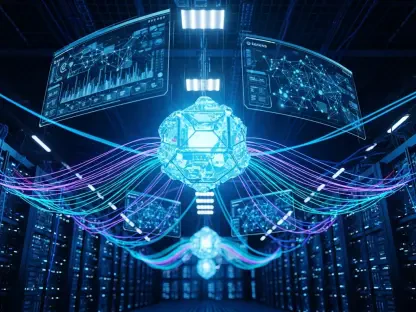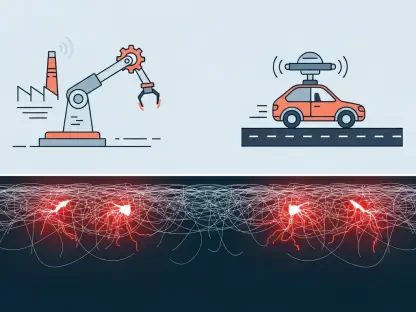In an era where cyber threats are evolving at an unprecedented pace due to the rapid integration of artificial intelligence, Palo Alto Networks has made a monumental move by acquiring CyberArk for a staggering $25 billion. This acquisition isn’t just a financial headline; it represents a calculated strategy to cement Palo Alto’s dominance in the identity security arena at a time when AI is fundamentally altering the cybersecurity landscape. While the immediate reaction saw a dip in stock prices following the announcement, many industry analysts view this as a visionary step with the potential to redefine how security challenges are addressed in the AI-driven world. The focus now shifts to understanding the deeper implications of this deal, particularly how it equips Palo Alto to confront the unique risks posed by emerging technologies. As AI continues to permeate every aspect of digital interaction, from personal assistants to industrial automation, the need for robust identity protection has never been more critical, setting the stage for a transformative shift in the industry.
The Strategic Fit of CyberArk
Strengthening Identity Security for the AI Era
The acquisition of CyberArk brings Palo Alto Networks a wealth of expertise in privileged access management (PAM) and identity and access management (IAM), both essential for safeguarding critical permissions and broader access controls in an increasingly complex digital environment. CyberArk’s specialized solutions address the intricate needs of securing high-level access, a growing concern as AI entities—whether digital agents or physical devices—require unique identities to operate securely. By folding these capabilities into its broader platform, Palo Alto aims to make advanced identity protection more cost-effective, potentially democratizing access to tools that were once prohibitively expensive for widespread adoption. This is particularly significant in tackling the concept of “proliferation of privilege,” where the expanding number of AI-driven entities necessitates scalable security measures to prevent unauthorized access and mitigate risks across diverse systems.
Beyond cost considerations, the integration of CyberArk’s technology positions Palo Alto to address some of the most pressing identity security challenges in the AI era. As AI systems take on more autonomous roles, such as managing personal data or operating in sensitive environments, the risk of credential theft or misuse skyrockets, often serving as the entry point for devastating attacks like ransomware. CyberArk’s proven track record in managing and securing identities offers a robust foundation for Palo Alto to build upon, ensuring that both human and non-human entities are protected under a unified security framework. This strategic alignment not only enhances Palo Alto’s offerings but also sets a new standard for how identity security must evolve to keep pace with technological advancements, particularly in environments where AI is becoming an integral part of operations.
Expanding Solutions for Emerging Threats
Another critical aspect of this acquisition is how it equips Palo Alto Networks to develop forward-thinking solutions for threats that are only beginning to emerge in the AI landscape. The complexity of securing identities for agentic AI—systems that act independently on behalf of users—requires innovative approaches that go beyond traditional security models. CyberArk’s expertise provides a pathway to create secure, distinct identities for these AI entities, reducing the risk of breaches that could compromise entire networks. This focus on preemptive security measures highlights Palo Alto’s commitment to staying ahead of cybercriminals who are quick to exploit new technologies for malicious purposes, ensuring that identity remains a fortified line of defense.
Additionally, the deal underscores the importance of addressing identity security in high-stakes sectors where AI adoption is accelerating. Industries such as healthcare and finance, which handle sensitive data and critical operations, stand to benefit immensely from the enhanced capabilities that CyberArk brings to Palo Alto’s portfolio. By integrating advanced PAM and IAM solutions, Palo Alto can offer tailored protections that safeguard against the unique vulnerabilities introduced by AI-driven systems, whether they are digital agents managing transactions or physical devices interacting in real-world settings. This comprehensive approach not only strengthens Palo Alto’s market position but also builds trust among enterprises navigating the uncertainties of AI integration, paving the way for broader industry adoption of secure practices.
Platformization in Cybersecurity
Building a Unified Defense Against Threats
The cybersecurity industry has been undergoing a significant transformation through platformization, a trend that consolidates specialized tools into comprehensive systems offering greater visibility and more effective threat responses. Palo Alto Networks has long been at the forefront of this movement, integrating diverse solutions to provide deeper insights across the ever-expanding attack surface. The acquisition of CyberArk fits seamlessly into this strategy, enhancing Palo Alto’s ability to tackle identity-based breaches, which remain a primary entry point for attackers, especially in the context of AI-driven threats. By unifying CyberArk’s identity security strengths with its existing platform, Palo Alto creates a more robust defense mechanism capable of detecting and responding to sophisticated attacks that exploit identity vulnerabilities in modern networks.
This move also reflects a broader industry shift toward data-driven security, where access to extensive datasets enables companies to anticipate and neutralize threats more effectively. Palo Alto’s history of successfully integrating acquisitions into a cohesive platform demonstrates its technical prowess in leveraging data for actionable insights. With CyberArk’s addition, the company gains a critical edge in addressing the fragmented nature of the identity security market, where standalone solutions often fall short against coordinated attacks. This strategic consolidation not only bolsters Palo Alto’s competitive standing but also sets a precedent for how cybersecurity providers must evolve to meet the demands of an AI-centric world, where threats are increasingly complex and interconnected across digital and physical realms.
Enhancing Scalability Through Integration
A key benefit of incorporating CyberArk into Palo Alto’s platform lies in the scalability it offers to enterprises facing escalating security demands. As organizations adopt AI technologies at an accelerating pace, the need for scalable identity security solutions becomes paramount to protect an ever-growing number of users, devices, and agents. CyberArk’s specialized tools, when combined with Palo Alto’s expansive platform, enable the delivery of seamless, enterprise-wide security that can adapt to varying scales of operation without compromising on efficacy. This integration ensures that businesses, regardless of size, can implement robust identity protections that evolve alongside their technological advancements, a critical factor in maintaining resilience against cyber threats.
Moreover, the focus on platformization through this acquisition addresses the inefficiencies of managing multiple point solutions, which often create gaps in security coverage. By offering a unified system that encompasses identity security alongside other protective measures, Palo Alto reduces the operational burden on IT teams tasked with safeguarding complex environments. This streamlined approach not only enhances threat detection and response capabilities but also aligns with the industry’s push toward efficiency and effectiveness in cybersecurity management. The result is a more agile defense posture that can swiftly adapt to the dynamic nature of AI-related risks, positioning Palo Alto as a leader in delivering holistic security solutions for the modern enterprise.
Addressing AI-Specific Security Challenges
Navigating the New Frontier of Agentic and Physical AI
The rapid proliferation of agentic AI—systems designed to act autonomously on behalf of users—presents a new frontier of security challenges that traditional measures are ill-equipped to handle. Imagine an AI agent tasked with rebooking a flight; the question of whether it should access personal credentials or operate under a separate digital identity raises significant security concerns. CyberArk’s expertise in managing access and privileges equips Palo Alto Networks to develop pioneering solutions for these scenarios, ensuring that AI interactions remain secure without compromising user convenience. This capability is vital as AI becomes more embedded in daily tasks, expanding the attack surface and necessitating innovative approaches to protect against unauthorized access and potential breaches.
Equally important is the application of identity security to physical AI devices, such as autonomous robots or machinery used in critical sectors like healthcare. These devices, often operating in sensitive environments, require distinct identities to prevent misuse or interference that could have severe consequences. The integration of CyberArk’s solutions into Palo Alto’s platform offers a robust framework for securing such technologies, ensuring that they function safely within their designated roles. By addressing the unique risks associated with physical AI, Palo Alto demonstrates a forward-thinking approach to cybersecurity, anticipating needs that will only grow as these devices become more prevalent in industries where precision and safety are paramount.
Pioneering Protections for an Expanding Attack Surface
As AI technologies continue to evolve, the attack surface they create expands exponentially, encompassing both digital and physical dimensions that demand specialized protections. Agentic AI, with its ability to manage personal and professional tasks, introduces vulnerabilities that cybercriminals can exploit through credential theft or identity spoofing. Palo Alto Networks, bolstered by CyberArk’s advanced identity management tools, is well-positioned to pioneer defenses that mitigate these risks by establishing secure protocols for AI interactions. This proactive stance not only safeguards users but also builds confidence in the adoption of AI technologies across various sectors, fostering innovation without the looming threat of security breaches.
In parallel, the rise of physical AI devices underscores the need for tailored security measures that account for their unique operational contexts. From autonomous delivery systems to robotic assistants in medical facilities, these technologies must be protected against tampering or unauthorized control. CyberArk’s integration into Palo Alto’s ecosystem enables the development of identity solutions that ensure these devices operate securely, maintaining integrity in high-stakes environments. This comprehensive approach to securing the expanding attack surface positions Palo Alto as a trailblazer in AI security, addressing both current and future challenges with a depth of expertise that few competitors can match.
Industry-Wide Implications
Setting the Stage for Consolidation and Scale
Looking back, the acquisition of CyberArk by Palo Alto Networks marked a pivotal moment that signaled a potential wave of consolidation within the identity security market. This strategic move suggested that other players in the space might become targets for acquisition as rival firms sought to enhance their own capabilities in response to growing AI-driven threats. The deal highlighted a broader industry trend toward achieving scale, where larger, data-driven platforms became essential for staying ahead of increasingly sophisticated cyberattacks. By integrating CyberArk, Palo Alto set a benchmark for how cybersecurity firms could evolve through strategic acquisitions to offer comprehensive solutions, addressing the multifaceted challenges of the modern threat landscape with greater efficacy.
Shaping Future Cybersecurity Strategies
Reflecting on the impact, this acquisition also prompted a reevaluation of how cybersecurity strategies were crafted to meet the demands of an AI-centric world. It became clear that the future of the industry would hinge on the ability to leverage vast datasets and integrated platforms to anticipate and neutralize threats before they escalated. Palo Alto’s forward-thinking approach in acquiring CyberArk served as a catalyst for competitors to consider similar consolidations, driving a shift toward unified security architectures. Moving forward, the focus should remain on fostering innovation in identity security, investing in technologies that adapt to emerging AI applications, and encouraging collaboration across the industry to build resilient defenses against the evolving nature of cyber risks.









